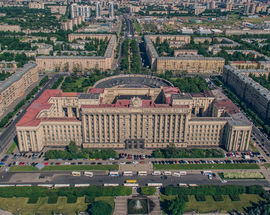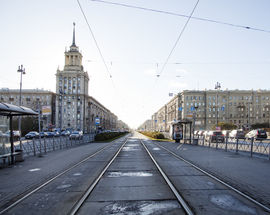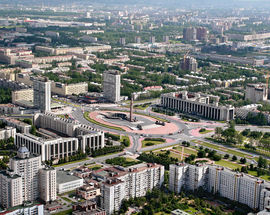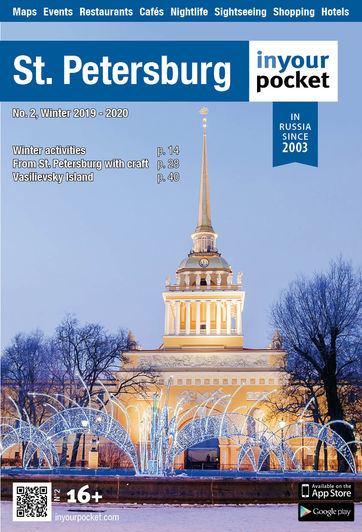Moskovsky District
more than a year agoMoskovsky District was founded in 1919 and was incorporated into St. Petersburg’s city boundaries in 1965. The northern part of Moskovsky District is home to Moskovskie Vorota (Moscow Gates) and the southern part is particularly important to the city’s – and indeed entire region’s – residents because that’s where Moskovsky Prospekt leads to St. Petersburg’s Pulkovo International Airport. This is also why the district is sometimes called the southern gateway of the city.
The name Moskovskaya Zastava originates from the post that existed back in the 18th century at the intersection of Moscow Road and Ligovsky Canal. Up to the end of the 19th century, Moskovskaya Zastava remained a sparsely populated territory with rural settlements but in the late 19th - early 20th centuries major transformations started to occur and the area was developed mainly thanks to the arrival of industrial enterprises such as Simens-Schuckert Plant, Carriage-Building Plant, Plant of the Skorokhod Association, etc.
The Moscow Road also played a very important role in the Russian royal family’s life because it was this road that led to the Tsarskoye Selo, the imperial countryside residence. Of course, the royal family wanted to travel to their countryside residence in comfort and in style, so with each year this road (by that time renamed to Tsarskoselkaya Road) became more modern, wide and beautiful. In the 1770s, marble mileposts were installed along the way; many have survived to this day.
On October 16, 1838 the Moscow Gates were unveiled and have since been the most recognizable symbol of Moskovsky District. Designed by architect V.P. Stasov, Moskovskie Vorota stand on the intersection of Moskovsky Prospekt and Ligovsky Prospekt in commemoration of the Russian military victories in the Russo-Turkish War of 1828-29. The chief material used in building the gate was cast iron. In fact, at the time of its opening, the Moscow Gates were the largest structure in the world made of cast iron. The monumental portico made of the powerful columns symbolized greatness and glory of the Russian army. The war victory theme was further underlined with the sculpture compositions of war trophies, signs and weapons.
Several years later, in 1845, the Novodevichy Convent of Holy Resurrection was built by order of Emperor Nicholas I, who decided to recreate the abolished Smolny Convent at a new location. By 1849, the Novodevichy Cemetery came to be and was a popular burial site for the city’s elite.
After the Bolshevik Revolution the street was renamed to Mezhdunarodny (International) Prospekt. In the 1930s, constructivism was the name of the game for the city’s architects – “what functions well also looks good”, went the saying. The southern stretch of the prospekt features an ensemble of buildings built in the distinctive Stalinist style in the 1930–1950s. One of the most notable buildings among those is the House of Soviets (1941), which was a military stronghold and command post during the Siege in World War II. The “House with a spire” is another typical building from those days. It is located on 190 Moskovsky Prospekt, was designed by G. Simonov, B. Rubanenko and V. Vasilkovsky and was built between 1940-41 (the tower was put up in 1953).
Also, in the 1930s the district lost its most recognizable symbol – the Moscow Gate. In 1936, during the period of Joseph Stalin’s concentration of power over the Leningrad leadership, the historic gate was dismantled with plans to move them to Moscow Square Park. Later, during the Siege of Leningrad in 1941, when the German army approached the outskirts of Leningrad, the cast iron blocks of the gate were used in creating an anti-tank defensive structure near the southern border of the city, helping to repel the Germans during the siege. Fortunately, the gate was restored from 1958 to 1960.
A very important date in the history of Moskovsky District was July 7, 1946. On this day, the Moskovsky Victory Park was officially opened; the name was given in honor of the Soviet victory in World War II. Victory Park was created as the area redevelopment of the former site of the brick factory soon after World War II ended. The factory site and surrounding area carried a sorrowful reminder for surviving citizens. During the war, the factory facilities were used to cremate victims of German blockade and bombardments during the Siege of the city.
Upon the park’s opening it covered only the 1/7 of the present-day territory. During the next decade, the park grew to the present-day boundaries. The original quarries, trenches and foxholes were preserved and further developed into a system of channels and small ponds. The 1950s saw construction projects in the park led by Soviet architects E.
Katonin and V. Kirhoglani; a summer stage, fountains and several pavilions including two propylaea-like buildings at the main entrance came into existence. In further years, sculptures and monuments were installed throughout the park. A major alley called “Alley of Heroes” features busts of Soviet heroes.
After the fall of the Soviet Union an Orthodox chapel and commemorative plaque were erected at the former site of the crematory facility. Nowadays, the park is a major leisure and recreation area not only for residents of Moskovsky District but residents of other St. Petersburg neighborhoods.
A small amusement park, playgrounds, cafés, boat rental, mini-golf, tennis courts and an outdoor ice skating rink make it the perfect destination for outdoor fun. To get to the park simply get out at the Park Pobedy metro station.
A couple of years ago, the district’s main road – Moskovsky Prospekt – underwent extensive renovations and is now even more modern, green, spacious, walkable and liveable! Moskovskaya Square now boasts a breath-taking fountain complex made up of 11 fountains that blast water some 12-14 meters towards the skies, accompanied by music and a yellow-blue-red light show.
Other areas of the district that got a facelift in recent years were the squares near Skazki Theater, Zenit movie theater and Chernogorskaya Street. Some 70,000 flowers are planted every spring and give visitors coming in from Pulkovo Airport a beautiful and colorful welcome. One of the largest libraries in the world – the Russian National Library – is located here.
/st-petersburg-en/russia-my-history_153029v
Russia – My History is a large-scale multimedia educational and exhibition complex located right next to St. Petersburg’s Victory Park. The total area of the …
/st-petersburg-en/moskovsky-department-store_128300v
The Moskovsky Department Store is a large mall located on Moskovsky prospect, one of the city’s main roads as you approach St. Petersburg from the airport. The …
/st-petersburg-en/pulkovo-airport_141636v
St. Petersburg's international terminal Pulkovo (LED) is located in the south of the city (metro Moskovskaya). It is located 23 km away from the Palace Square. …
/st-petersburg-en/raduga-shopping-and-entertainment-center_152274v
Raduga Shopping and Entertainment Center opened its doors in 2007 on Kosmonavtov Prospekt and has since been a popular place for many St. Petersburg residents. …
/st-petersburg-en/pryanosti-radosti-moskovsky_151871v
This is a very cosy and already extremely popular restaurant. On entering, you might even say too popular. The tables are spaced close to each other and a …
/st-petersburg-en/manneken-pis-moskovsky_151864v
Manneken Pis is named after the famous 61 cm. statue in Brussels. This bar looks like your standard European bar, but just wait till you see the beer menu. …
/st-petersburg-en/grill-station_151714v
As the name might suggest, it’s all about fire in this restaurant! Grill Station is not a steak house, but rather a place where everything – meat, fish, …
/st-petersburg-en/mozzarella-bar_53510v
Mozzarella Bar is an elegant Italian trattorria were guests can feed their pasta, pizza, fish and meat cravings in a warm atmosphere! The pizza offering …
/st-petersburg-en/holiday-inn-moskovskye-vorota_48122v
This huge hotel has the business traveller firmly in mind. There are three bars and two restaurants, a fitness centre and extensive state-of-the-art conference …
/st-petersburg-en/crowne-plaza-st-petersburg-airport_93715v
Situated close to the Pulkovo airport, this is the city's first airport hotel. A modern design on the building's facade includes quirky windows in the guest …








Comments